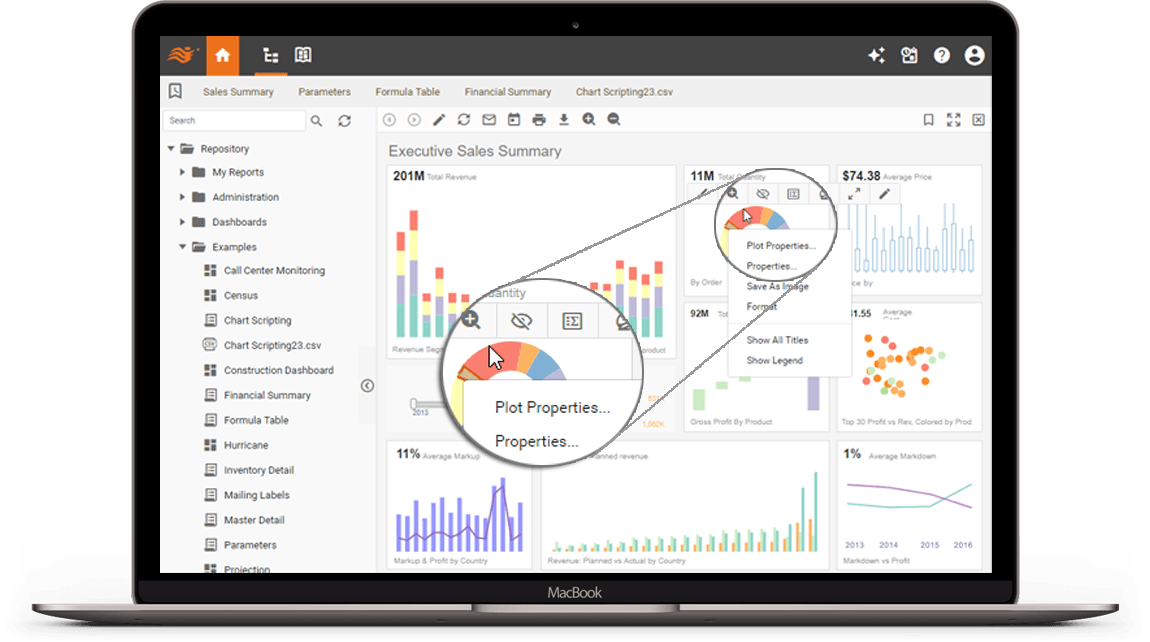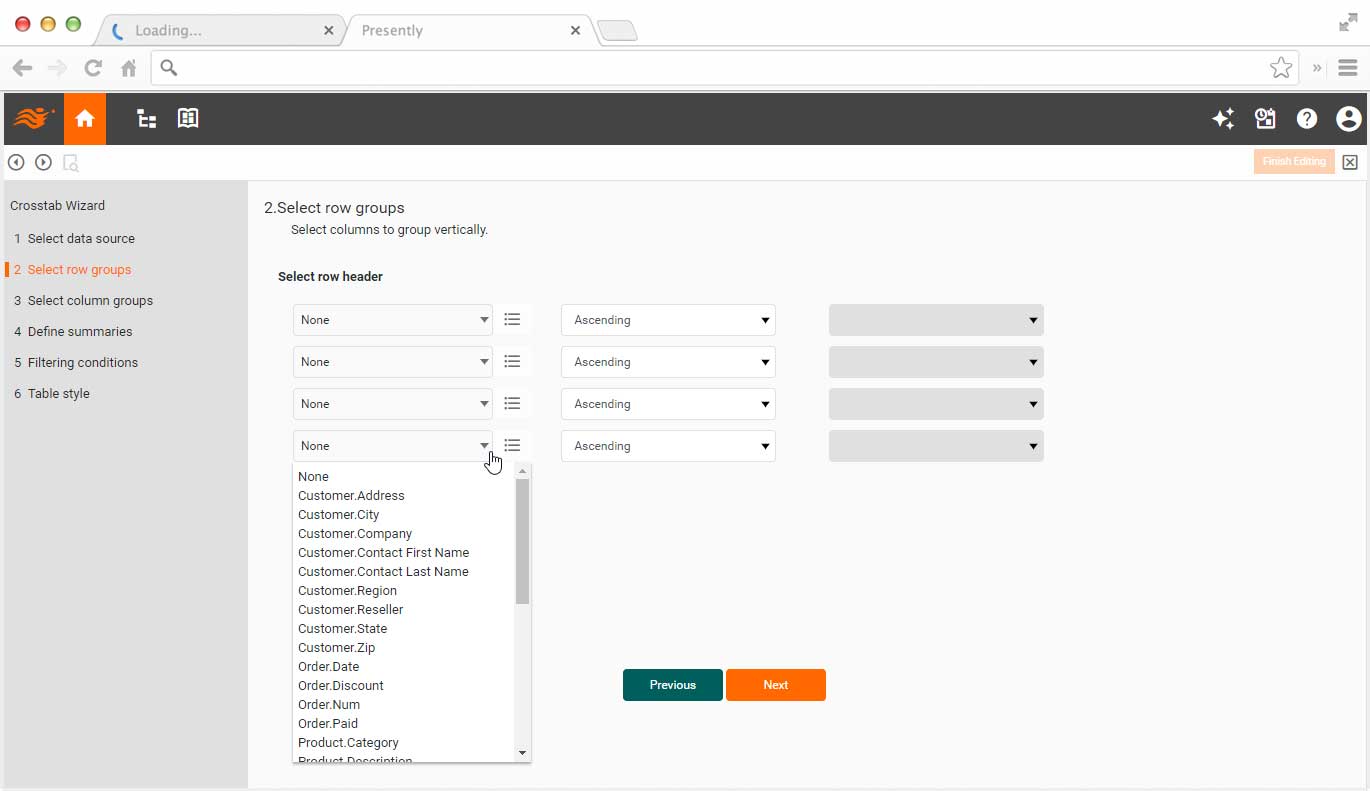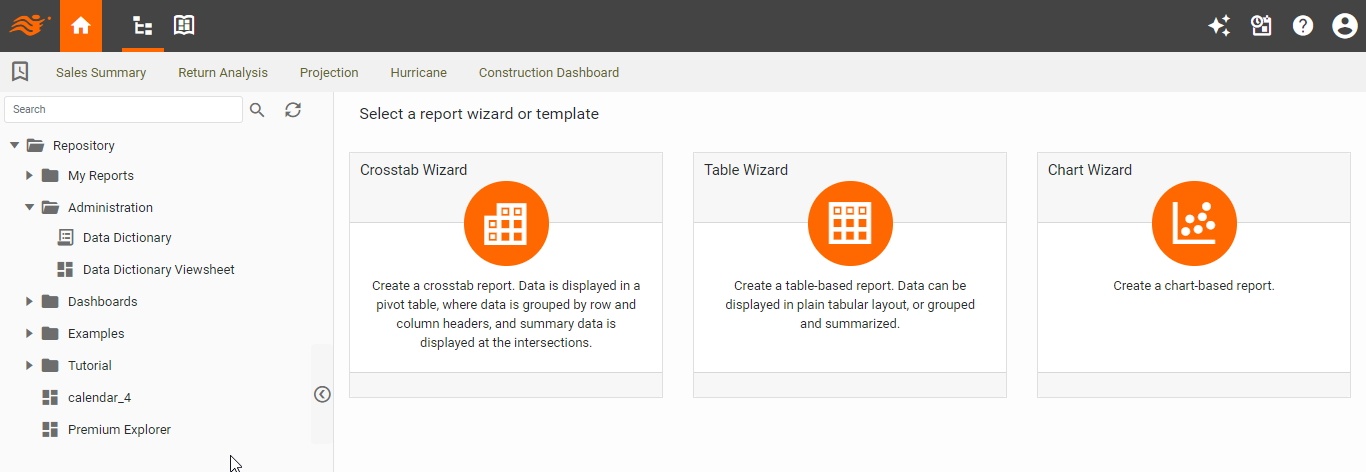Ad Hoc Reporting and Self-Service Visualization
Ad hoc reporting empowers business users with self-service information access. An effective ad hoc tool must have two key components: data and visuals. Data access components must present intuitive views of business data. Visual components should give novice users the ability to either visually analyze the data or retrieve it as documents or data files.Visual Dashboard Customization
All visualizations, dashboards, and document reports published in the InetSoft web app have built-in fine-grained self-service customization. If a business need is similar to an existing report or dashboard, this ad hoc need can probably be satisfied by simple customization.

Business Data Views for SQL Databases, OLAP Data Warehouses & More
Users are presented with simple, intuitive business data views based on underlying data models. The data models not only factor out technical details, they also provide data security control and runtime safeguards against runaway queries.


Guided Steps to Visual Analytic Dashboards or Document Reports
InetSoft's web app guides business users step-by-step for ad hoc reporting. Interactive analytic dashboards, published document reports or downloaded query data are all at users' fingertips.

Spotlight: Analyses That a Cardiologist Does
Cardiologists are medical specialists who focus on diagnosing and treating diseases and disorders of the heart and blood vessels. They perform a wide range of analyses to assess cardiovascular health, evaluate cardiac function, and manage cardiovascular conditions. One common type of analysis conducted by cardiologists is diagnostic testing, which includes electrocardiography (ECG or EKG), echocardiography, stress testing, and cardiac catheterization. These tests provide valuable information about heart rhythm, blood flow, cardiac structure, and function, helping cardiologists diagnose conditions such as arrhythmias, coronary artery disease, heart failure, and valvular heart disease.
In addition to diagnostic testing, cardiologists use risk assessment tools and algorithms to evaluate patients' risk of developing cardiovascular diseases and assess their overall cardiovascular health. They analyze various risk factors, including age, gender, family history, smoking status, blood pressure, cholesterol levels, diabetes, and obesity, to stratify patients into different risk categories and guide preventive interventions. By identifying individuals at high risk of cardiovascular events, such as heart attacks or strokes, cardiologists can implement personalized treatment plans and lifestyle modifications to reduce cardiovascular risk and improve long-term outcomes.
Furthermore, cardiologists perform therapeutic monitoring and follow-up evaluations to assess the effectiveness of treatment interventions and manage patients with cardiovascular conditions. They analyze laboratory test results, such as cardiac biomarkers, lipid profiles, and blood pressure measurements, to monitor disease progression, evaluate treatment response, and adjust medications or interventions as needed. Cardiologists also collaborate with multidisciplinary teams, including primary care physicians, cardiac surgeons, interventional cardiologists, and cardiac rehabilitation specialists, to provide comprehensive care for patients with complex cardiovascular diseases and optimize their outcomes through evidence-based medicine and personalized treatment approaches.
Spotlight: Analyses That a Pulmonologist Does
A pulmonologist specializes in diagnosing and treating conditions of the lungs and respiratory system, and one of the primary types of analyses they perform is pulmonary function testing (PFT). These tests measure how well the lungs are working by assessing airflow, lung volume, and the ability to transfer oxygen into the blood. Common PFTs include spirometry, which evaluates how much air a patient can exhale and how quickly, and diffusion capacity tests, which show how effectively gases like oxygen pass from the lungs into the bloodstream. These analyses help detect conditions such as asthma, chronic obstructive pulmonary disease (COPD), and pulmonary fibrosis.
Another critical analysis a pulmonologist performs is imaging-based evaluation, often using chest X-rays, CT scans, and sometimes MRIs to visualize the lungs and surrounding structures. Imaging can reveal blockages, tumors, fluid buildup, infections, or scarring that may not be evident from physical exams alone. In addition, pulmonologists may conduct bronchoscopy — a direct visualization of the airways using a thin, flexible tube with a camera — to collect tissue samples, remove blockages, or identify sources of bleeding. These procedures provide a detailed picture of both structural and pathological changes in the lungs.
Finally, pulmonologists analyze arterial blood gases (ABGs) and sleep studies to better understand respiratory efficiency. ABG tests measure levels of oxygen, carbon dioxide, and blood pH, which indicate how well the lungs are exchanging gases. Sleep studies, particularly for patients with suspected sleep apnea, evaluate breathing patterns, oxygen levels, and airway obstructions during rest. By combining functional tests, imaging, and laboratory analyses, a pulmonologist can create a comprehensive understanding of a patient’s respiratory health and tailor treatment plans that range from medications and inhalers to advanced interventions like pulmonary rehabilitation or surgery.
